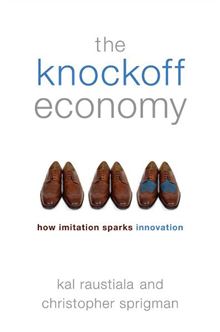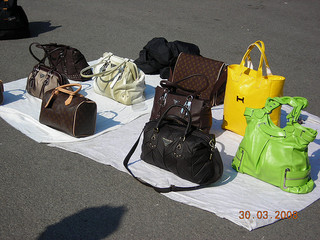Why Knockoffs Can Help Build a Strong Brand
Here is an excerpt from The Knockoff Economy: How Imitation Sparks Innovation, which has just been published by Oxford University Press. Next week, we’ll be taking questions from Freakonomics readers in a Q&A. We’ll also run a contest for the wackiest photo of a knockoff item.
 THE KNOCKOFF ECONOMY
THE KNOCKOFF ECONOMY
CONCLUSION
The traditional justification for trademark law, which protects brands, has little to do with innovation. Instead, trademark law’s justification is that brands help consumers identify the source of products, and thereby buy the item they want–and not an imitation. And yet brands—like Apple, or J. Crew–play an important and often unappreciated creativity-inducing role in several of the industries we explore in The Knockoff Economy.
Put in economic terms, trademarks reduce the search costs associated with consumption. If you’ve had a positive experience with basketball shoes from Adidas, then marking them with the trademark-protected three-stripes helps ensure that you can quickly find their shoes the next time you are shopping. And of course it also lets everyone else know which shoes you prefer.
So brands are fundamentally a shortcut—rather than try on lots of shoes, we save time by heading straight for the Adidas rack. Brands can be extremely valuable as a result, and firms take expensive measures to develop and protect them.
Copying brands—what is called counterfeiting—is illegal, and usually for good reason. But even the copying of brands can have some positive effects. Copying may serve as advertising for brands—advertising that is not only free but arguably more powerful because it stems from the authentic actions of consumers rather than the carefully-produced efforts of producers.
In a fascinating paper, legal scholar Jonathan Barnett explored the ways in which, in the fashion industry, brand owners benefited even when knockoff artists not only took their designs but also counterfeited their brands. Barnett argued that the presence of counterfeits may actually help brand owners by signaling to high-end consumers the desirability of the original item as part of an emerging fashion trend. Because the counterfeit copies are most often of lower quality, consumers usually can tell they’re not the real thing. At the same time, Barnett argues, their presence on the streets signals that the dress, handbag, or shoes they are aping are especially desirable. Counterfeits communicate the fact that even those who can’t afford to have the real thing still want it. That’s a free ad for the branded product.
Other studies support the power of copies as a form of advertising. A two-and-one-half year study by Renee Gosline of the Massachusetts Institute of Technology looked at people who purchase counterfeit luxury items, like handbags and sunglasses, and found that counterfeits do not hurt the sales of luxury brands so long as consumers can distinguish between them. Indeed, Gosline found that counterfeits are often used as “trial versions” of the high-end genuine branded item, with over 40% of counterfeit handbag consumers ultimately purchasing the real brand.
Gosline’s study suggests that fake luxury goods are a very effective form of advertising: people who buy them and live with them have a significant probability of being converted to the brand and buying the real thing once they can afford to do so. Copies, in short, are a kind of “gateway drug” that leads to consumption of the harder (or at least, more expensive) stuff. What’s more, every time consumers go out with their fake item, they’re publicly displaying the desirability of the brand, sparking trend-driven consumption that spills over—or up—to the original version.
Gosline’s and Barnett’s findings are broadly reinforced by other recent research. A 2011 study by economist Yi Qian for the National Bureau of Economic Research looked at data from 31 branded shoe companies, as well as a number of counterfeiters, operating in China in 1993–2004. The study likewise found that counterfeiting had a surprisingly positive effect on the sales of high-end branded items.
The tendency of counterfeits to advertise the desirability of the branded product—what we will call the “advertising effect”—outweighed any substitution effect, by which we mean the effect of consumers purchasing the counterfeit instead of the original. The substitution effect is harmful for creators, and the advertising effect is helpful. And only for low-end branded products did the substitution effect outweigh the advertising effect.
In short, copies of branded goods—counterfeits—can have a counterintuitive effect on originals. While these copies can steal away some would-be buyers of the original, they also can help create new buyers through the advertising effect. Some counterfeit buyers “graduate” to the real thing, whereas others who never buy a counterfeit become buyers of the original because the counterfeits serve as advertising.
This point is not limited to formal brands—that is, to the kinds of brands protected by trademark law. The basic dynamic of the advertising effect can also be seen in individual creators, who can build a very valuable name for themselves as innovators.
Los Angeles–based chef Ludovic Lefebvre, for instance, is not a brand in the formal sense. But his name and personality draw big crowds, providing him with several ways, besides actually getting behind the stove, to gain value from his skill as an innovative chef: cookbook author, consulting chef, Top Chef: Masters contestant, and so forth. In 2011, he even debuted his own television show, Ludo Bites America, on the Sundance Channel. And it is enough to know that a new restaurant is run by Lefebvre—or by any of a number of other famous chefs—for legions of fans to show up. Like shoppers in the shoe store seeking the Adidas rack, they know what the Ludo Lefebvre brand entails.
Unauthorized copies, in turn, can serve as unintended advertisements in the same way we have described. In some cases the unauthorized copy is a noteworthy dish that soon appears in competitor restaurants and sparks interest in the original. Being copied in this way can reinforce a reputation as an innovator and elevate a chef’s standing in the public eye.
Advertising via copying is perhaps the most powerful endorsement a brand can hope for. Few people believe that the celebrities in glossy product ads really consume the product they are shilling: we are too jaded for that, even if the halo effect of a celebrity somehow renders the item in question more desirable. In this sense, conventional advertisements are inherently limited because they rarely convey authentic endorsement. A copy, by contrast, is as sincere an endorsement of quality and desirability as any creator could hope for.


Comments